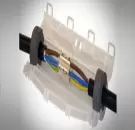Description/ Specification of Cable Jointing Services
Cable jointing services encompass a critical aspect of the electrical infrastructure industry, facilitating the connection and maintenance of various types of cables. These services are integral for ensuring the efficient transmission of power and data across diverse sectors, including telecommunications, energy, and transportation. Several key aspects characterize the domain of cable jointing services, encompassing the intricate processes, specialized skill sets, and safety measures that are imperative for the successful installation, maintenance, and repair of cable networks. One crucial aspect of cable jointing services is the technical proficiency required for the installation and repair of cables. Professionals in this field must possess in-depth knowledge of cable types, including power cables, fiber optic cables, and telecommunication cables, and understand the intricacies involved in their installation and maintenance. This includes expertise in handling cable insulation, shielding, and conducting proper terminations to ensure optimal performance and longevity of the cable networks. Moreover, a comprehensive understanding of industry-specific standards and regulations is essential to guarantee compliance with safety protocols and operational guidelines. Safety forms another vital aspect of cable jointing services. Given the high voltage nature of many cables, professionals must adhere to stringent safety measures to prevent electrical hazards and ensure the well-being of both themselves and the public. This includes the implementation of appropriate safety protocols, such as wearing protective gear, employing insulated tools, and conducting thorough risk assessments before initiating any cable jointing operation. Furthermore, adherence to industry safety standards, such as those outlined by the Occupational Safety and Health Administration (OSHA) or the International Electrotechnical Commission (IEC), is imperative to maintain a secure working environment and prevent potential accidents or mishaps. Additionally, the use of advanced technology and equipment constitutes a significant aspect of modern cable jointing services. With the continuous evolution of the electrical industry, professionals in this field must remain updated with the latest technological advancements and employ cutting-edge tools for efficient and precise cable installation and maintenance. This involves the utilization of specialized equipment for cable cutting, splicing, and testing, as well as the incorporation of advanced techniques such as heat-shrink and cold-shrink jointing methods to ensure seamless connectivity and optimal performance of cable networks. In conclusion, cable jointing services encompass a multifaceted domain that demands specialized technical expertise, strict adherence to safety protocols, and utilization of advanced technology for the seamless installation, maintenance, and repair of cable networks. A comprehensive understanding of these various aspects is crucial for professionals in the field to ensure the efficient functioning and longevity of the intricate electrical infrastructure that underpins numerous industries and modern society as a whole.
Cable Jointing Services
Cable jointing services encompass a critical aspect of the electrical infrastructure industry, facilitating the connection and maintenance of various types of cables. These services are integral for ensuring the efficient transmission of power and data across diverse sectors, including telecommunications, energy, and transportation. Several key aspects characterize the domain of cable jointing services, encompassing the intricate processes, specialized skill sets, and safety measures that are imperative for the successful installation, maintenance, and repair of cable networks. One crucial aspect of cable jointing services is the technical proficiency required for the installation and repair of cables. Professionals in this field must possess in-depth knowledge of cable types, including power cables, fiber optic cables, and telecommunication cables, and understand the intricacies involved in their installation and maintenance. This includes expertise in handling cable insulation, shielding, and conducting proper terminations to ensure optimal performance and longevity of the cable networks. Moreover, a comprehensive understanding of industry-specific standards and regulations is essential to guarantee compliance with safety protocols and operational guidelines. Safety forms another vital aspect of cable jointing services. Given the high voltage nature of many cables, professionals must adhere to stringent safety measures to prevent electrical hazards and ensure the well-being of both themselves and the public. This includes the implementation of appropriate safety protocols, such as wearing protective gear, employing insulated tools, and conducting thorough risk assessments before initiating any cable jointing operation. Furthermore, adherence to industry safety standards, such as those outlined by the Occupational Safety and Health Administration (OSHA) or the International Electrotechnical Commission (IEC), is imperative to maintain a secure working environment and prevent potential accidents or mishaps. Additionally, the use of advanced technology and equipment constitutes a significant aspect of modern cable jointing services. With the continuous evolution of the electrical industry, professionals in this field must remain updated with the latest technological advancements and employ cutting-edge tools for efficient and precise cable installation and maintenance. This involves the utilization of specialized equipment for cable cutting, splicing, and testing, as well as the incorporation of advanced techniques such as heat-shrink and cold-shrink jointing methods to ensure seamless connectivity and optimal performance of cable networks. In conclusion, cable jointing services encompass a multifaceted domain that demands specialized technical expertise, strict adherence to safety protocols, and utilization of advanced technology for the seamless installation, maintenance, and repair of cable networks. A comprehensive understanding of these various aspects is crucial for professionals in the field to ensure the efficient functioning and longevity of the intricate electrical infrastructure that underpins numerous industries and modern society as a whole.
